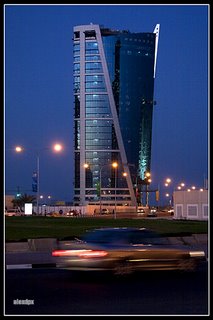
At twilight, the buildings and other city elements receives just enough lighting to be recognizable. At the same time, street lamps, billboards and other artificial lights are turned on.
 The city is alive at night!
The city is alive at night! The concept of night photography is simple - take pictures at night. Cityscapes and architecture are some of the most popular subjects during this time because of the twinkling street lights, neon signs, automotive lights and the buildings' own internal illuminations that shine through their windows.
The concept of night photography is simple - take pictures at night. Cityscapes and architecture are some of the most popular subjects during this time because of the twinkling street lights, neon signs, automotive lights and the buildings' own internal illuminations that shine through their windows.
The techniques for night shooting are relatively simple, however, I have observed that far too many are doing night shots actually at night, when the sky is already pitch black. I wouldn't say it's a wrong approach. It's just that, in the case of cityscapes, there are areas that do not get as much illumination or do not have any illumination at all as the main roads do. Then there are buildings with external lighting while many don't have. As a result, they appear as areas of black "patches" without any distinguishable details and do not contribute to the beauty of the picture.
In the case of individual buildings, you get a hardly recognizable building without any illumination against a black sky so what you get is just a collection of light dots - or spots, however you wish to call it.
For this reason, I prefer to do my night photography at twilight. It's those precious few minutes just after sunset when the sun is no longer visible from the horizon but it's rays would still cast those lovely deep dark blues, reds, oranges and even purples in the sky. The same light would provide just enough illumination into those areas of black patches and would cast gorgeous colors on the buildings' glass and aluminum facade.
 Even if the buildings' external finish is non-reflective (such as concrete and natural stone) its colors would be saturated beautifully. Plus, the illumination it provides on the building would look a lot better than the collection of light spots you get from photographing deep in the dark of night.
Even if the buildings' external finish is non-reflective (such as concrete and natural stone) its colors would be saturated beautifully. Plus, the illumination it provides on the building would look a lot better than the collection of light spots you get from photographing deep in the dark of night.
At about the same time, the artificial lights - street lamps, neons, building lights - all of them will have been turned on and it is simply gorgeous to have them work with and complement the remaining natural light for the day. Have you ever seen sky reflections on a building's glass window while the building's own internal lighting shines through the same glass? Spectacular, isn't it?
 As usual, take plenty of shots. Bracket them and experiment with different white balance / shutter speed / aperture combinations. See which ones give the best results. You might need a low grade ND filter to control those neons and light bulbs from blowing out in your picture.
As usual, take plenty of shots. Bracket them and experiment with different white balance / shutter speed / aperture combinations. See which ones give the best results. You might need a low grade ND filter to control those neons and light bulbs from blowing out in your picture.
In essence, photographing architecture at night is much the same as shooting during day time. You still need to do the preparations and planning as discussed in the previous article and a visual walk-around inspection prior to shooting is still the best way to explore the building's angles and viewpoints.  Verticals still need to be kept vertical, basically.
Verticals still need to be kept vertical, basically.
Everything still need to be sharp and well in focus, except, of course for moving cars and passers by that will inevitably appear in picture as light streaks and blurs because of your camera's slow shutter setting. But that is not something to be worried about. In fact, they add impact to the picture by showing that the city (or building) is dynamic and alive even at night.
Cheers,


4 comments:
beautiful shots and magical colors sir alex. i'm very inspired to take architectural shots at night soon... thanks for sharing... c",)
very nice points here. Really great shots. Thanks again for sharing your knowledge to us alex.
Shooting at twilight is also something that I rarely do. End of the day kasi, 'sarap umuwi agad at magpahinga - hehe. Pero pag sinipag, the reward of having colorful photos is inexplicable =)
Spectacular photos! I love 'em! And thanks for sharing tips =)
Post a Comment